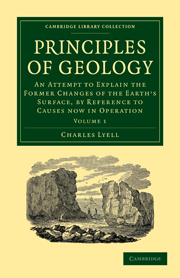 Principles of Geology
Principles of Geology Book contents
- Frontmatter
- Contents
- LIST OF PLATES AND WOOD-CUTS IN THE FIRST VOLUME
- CHAPTER I
- CHAPTER II
- CHAPTER III
- CHAPTER IV
- CHAPTER V
- CHAPTER VI
- CHAPTER VII
- CHAPTER VIII
- CHAPTER IX
- CHAPTER X
- CHAPTER XI
- CHAPTER XII
- CHAPTER XIII
- CHAPTER XIV
- CHAPTER XV
- CHAPTER XVI
- CHAPTER XVII
- CHAPTER XVIII
- CHAPTER XIX
- CHAPTER XX
- CHAPTER XXI
- CHAPTER XXII
- CHAPTER XXIII
- CHAPTER XXIV
- CHAPTER XXV
- CHAPTER XXVI
- INDEX
- Frontmatter
- Contents
- LIST OF PLATES AND WOOD-CUTS IN THE FIRST VOLUME
- CHAPTER I
- CHAPTER II
- CHAPTER III
- CHAPTER IV
- CHAPTER V
- CHAPTER VI
- CHAPTER VII
- CHAPTER VIII
- CHAPTER IX
- CHAPTER X
- CHAPTER XI
- CHAPTER XII
- CHAPTER XIII
- CHAPTER XIV
- CHAPTER XV
- CHAPTER XVI
- CHAPTER XVII
- CHAPTER XVIII
- CHAPTER XIX
- CHAPTER XX
- CHAPTER XXI
- CHAPTER XXII
- CHAPTER XXIII
- CHAPTER XXIV
- CHAPTER XXV
- CHAPTER XXVI
- INDEX
Summary
We have hitherto considered the changes wrought, since the times of history and tradition, by the continued action of aqueous causes on the earth's surface; and we have next to examine those resulting from igneous agency. As the rivers and springs on the land, and the tides and currents in the sea, have, with some slight modifications, been fixed and constant to certain localities from the earliest periods of which we have any records, so the volcano and the earthquake have, with few exceptions, continued, during the same lapse of time, to disturb the same regions. But as there are signs, on almost every part of our continent, of great power having been exerted by running water on the surface of the land, and by tides and currents on cliffs bordering the sea, where, in modern times, no rivers have excavated, and no tidal currents undermined—so we find signs of volcanic vents and violent subterranean movements in places where the action of fire has long been dormant. We can explain why the intensity of the force of aqueous causes should be developed in succession in different districts. Currents, for example, and tides, cannot destroy our coasts, shape out or silt up estuaries, break through isthmuses, and annihilate islands, form shoals in one place and remove them from another, without the direction and position of their destroying and transporting power becoming transferred to new localities.
- Type
- Chapter
- Information
- Principles of GeologyAn Attempt to Explain the Former Changes of the Earth's Surface, by Reference to Causes now in Operation, pp. 312 - 325Publisher: Cambridge University PressPrint publication year: 2009First published in: 1830


